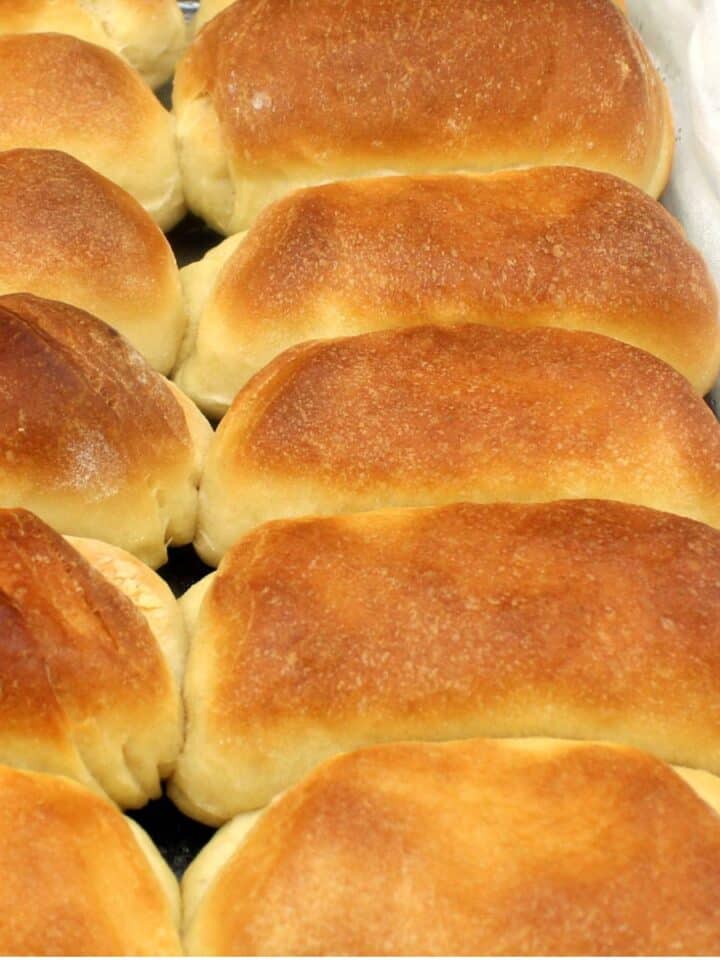A recipe and tips for making the most amazing homemade bagels. They are chewy, dense and flavorful, with the perfect, glossy, golden brown crust!
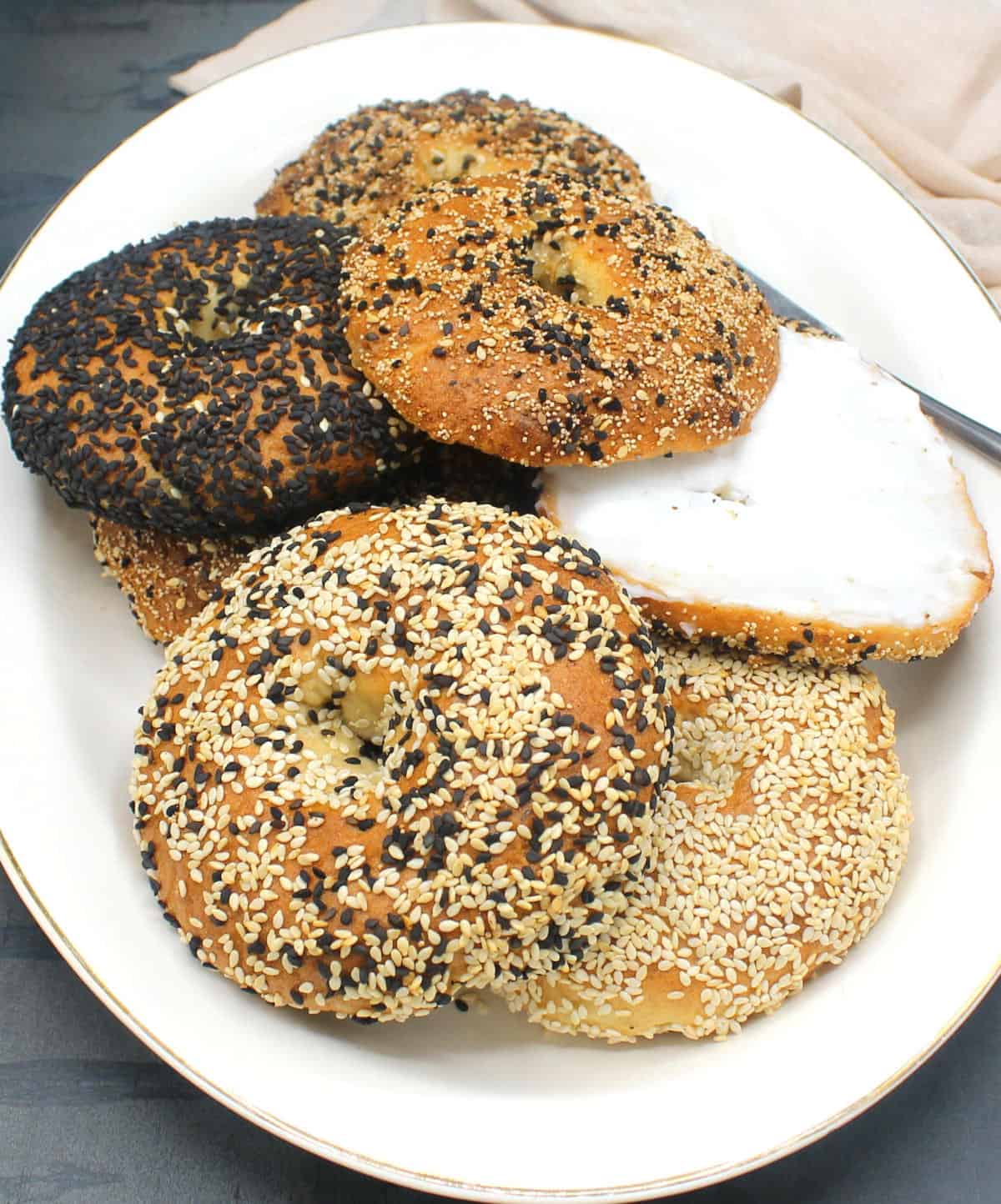
Here's a comprehensive guide to making the most perfect bagels you will ever eat. Best of all they are so easy to make -- beginner-level easy, in fact. And they have everything you look for in a bagel: a chewy, dense but soft crumb, a deliciously shiny and pleasantly stiff crust, and incredible flavor!
[feast_advanced_jump_to]Why you will love this bagel recipe
- Perfect bagels each time! Follow the instructions, especially on boiling and proofing times, and you will be enjoying amazing bagels in no time!
- Easy recipe. One might imagine a specialized bread would be tedious to make, and time-consuming, but the process of making bagels is rather easy. This was one of the first bread recipes I shared with you on Holy Cow Vegan, and they came out perfectly the first time I made them. Even shaping the bagels with that characteristic hole in the center is easier than, say, shaping a pretzel would be.
- Naturally vegan. Bagels are usually dairy-free and eggless and most bakers do not use non-vegan ingredients, so there are no compromises involved in making these vegan bagels!
- Loaded with flavor. The bagels are part whole grain, which not only makes them more nutritious than a store-bought bagel, it also makes them more flavorful. Adding the seed topping takes the taste of these yummy bagels up another notch.
What makes a bagel different from other breads
Apart from its distinctive texture and shape, what sets a bagel apart from other breads is the process of making it. Unlike other breads a bagel is proofed, then boiled and finally baked. While most new bakers might balk at the idea of dropping those perfectly proofed, gorgeous bagels in a huge pot of boiling water, rest assured that this will only enhance the bagels and make them even better.
Why are bagels boiled?
Bagels are boiled in order to achieve that characteristic texture. Dropping the proofed bagels into boiling water helps set the starches on the crust and gives the finished bagel that shiny, slightly tough crust you adore.
Usually a bit of barley malt syrup or sugar or honey is added to the boiling water bath in order to add more gloss. Some bakers add baking soda to the water to promote browning. In this recipe we will add a bit of maple syrup or sugar for the same effect.
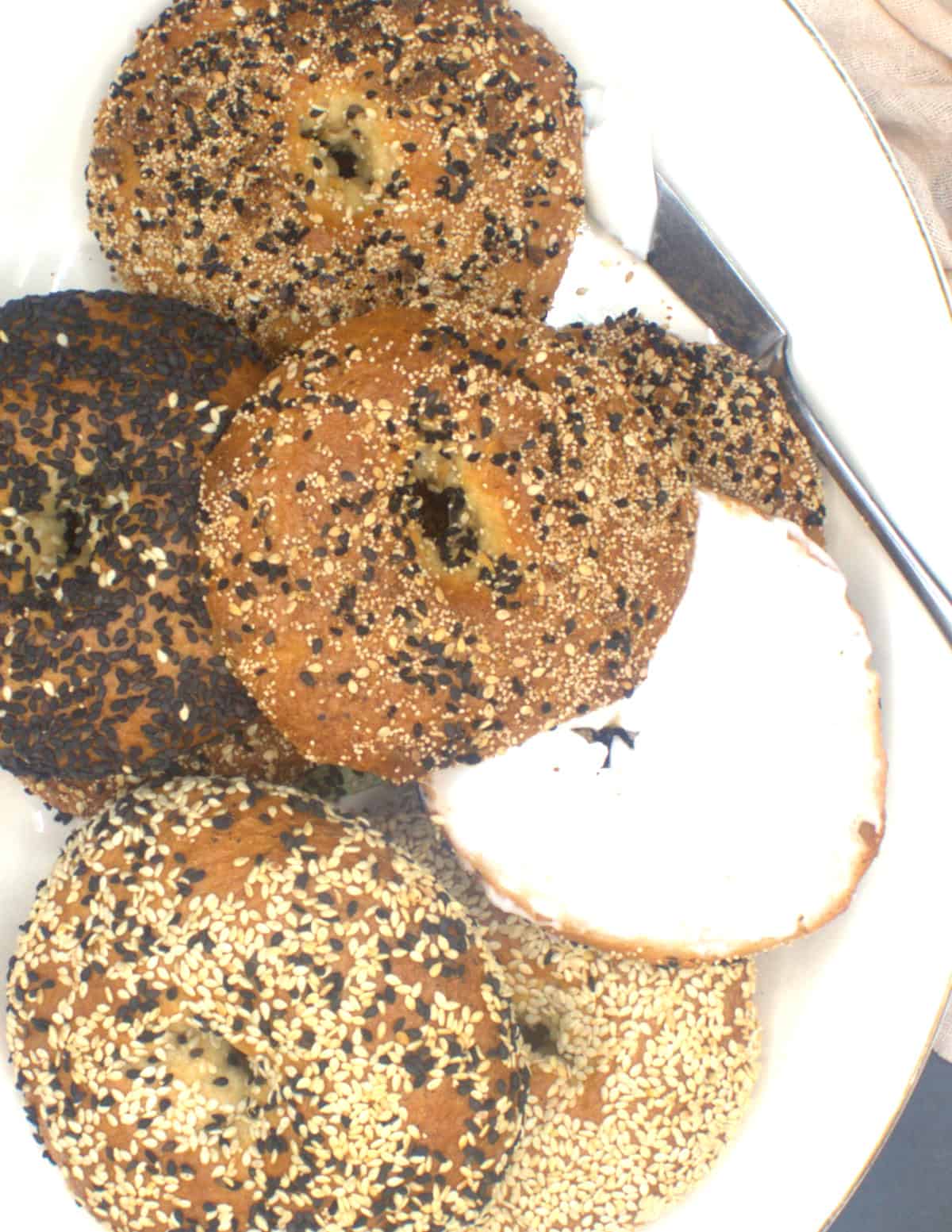
Are all bagels vegan?
Here's the great thing about bagels: bagel dough does not require milk, eggs or butter, so most bagels you are likely to encounter in stores and bakeries are very likely vegan. But as always, ask if you aren't sure and read labels before buying. Letting businesses know you are looking specifically for vegan foods can encourage them to stock more cruelty-free products, which is a win-win for us as vegans, the planet and, most importantly, the animals.
Ingredients
- Yeast: Either active dry yeast or instant yeast works for this recipe. If using active dry yeast wait a couple of minutes for it to bloom after adding the water and maple syrup/sugar.
- Flours: whole wheat flour and bread flour.
- Maple syrup or sugar. Either works for this recipe. Or use another sweetener like agave nectar.
- Oil for coating the bowl. You don't need any oil in the bagel dough.
For bagel seasoning (optional)
- Sesame seeds
- Poppy seeds
- Nigella seeds (optional, but very nice)
- Onion flakes
- Powdered garlic or garlic flakes
- Salt.
Variations
- For cinnamon raisin bagels, add ¼ cup sugar and ½ cup raisins to the dough.
- For chocolate chip bagels, add ¼ cup sugar and ½ cup chocolate chips to the dough.
- For blueberry bagels, add ¼ cup sugar and 1 cup fresh blueberries to the dough. Cut down the water to 1 cup and add more flour if needed because the blueberry will express some juices.
How to make bagels
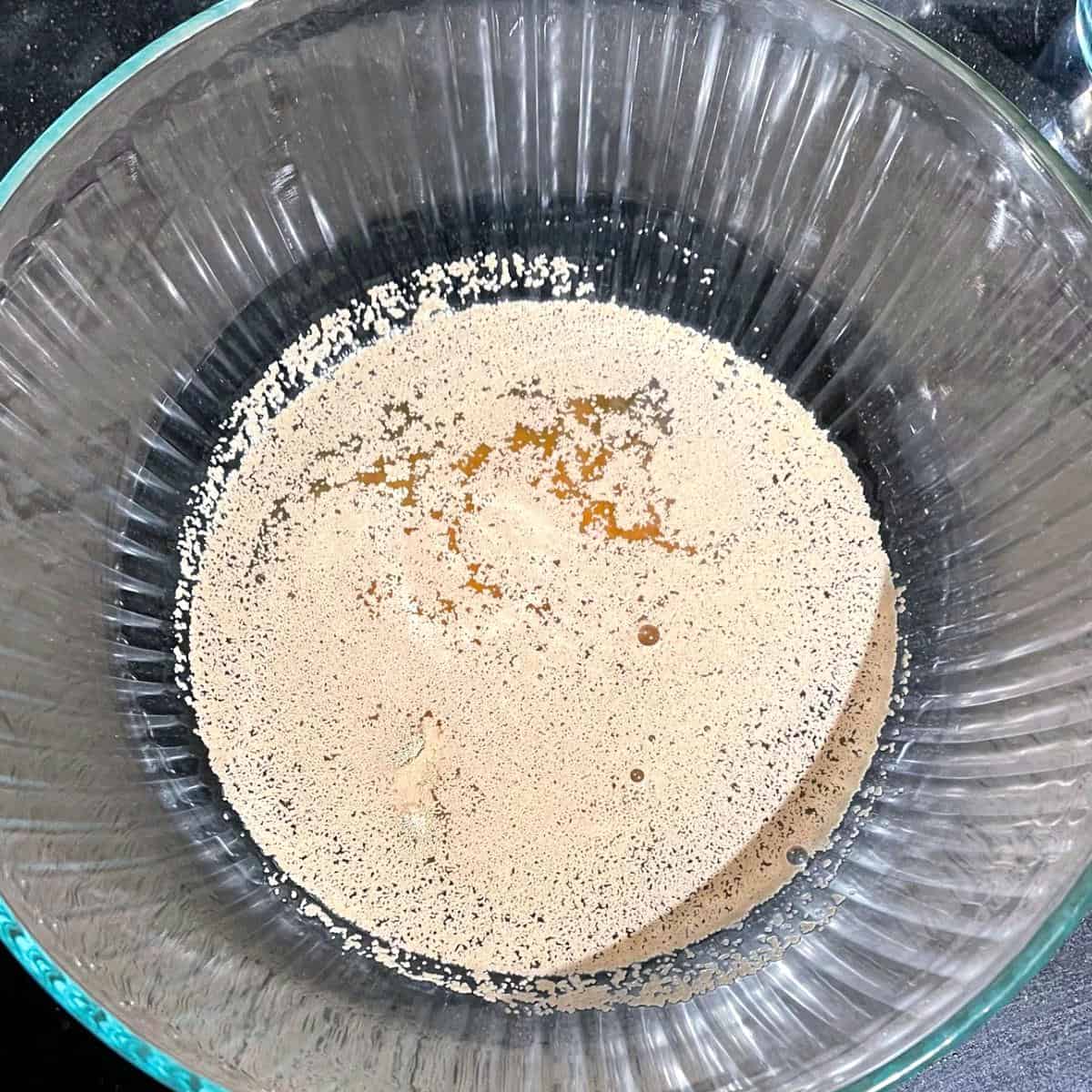
Place warm water, yeast and maple syrup or sugar in a large bowl.

Add one cup of whole wheat flour and two cups of bread flour to the bowl. Use a wooden spoon or your hands to mix until a dough forms. Turn out the dough on an unfloured surface and knead. If the dough seems too soft and sticky, add flour to it. You might need up to half cup more flour, but add only a tablespoon or two at a time.
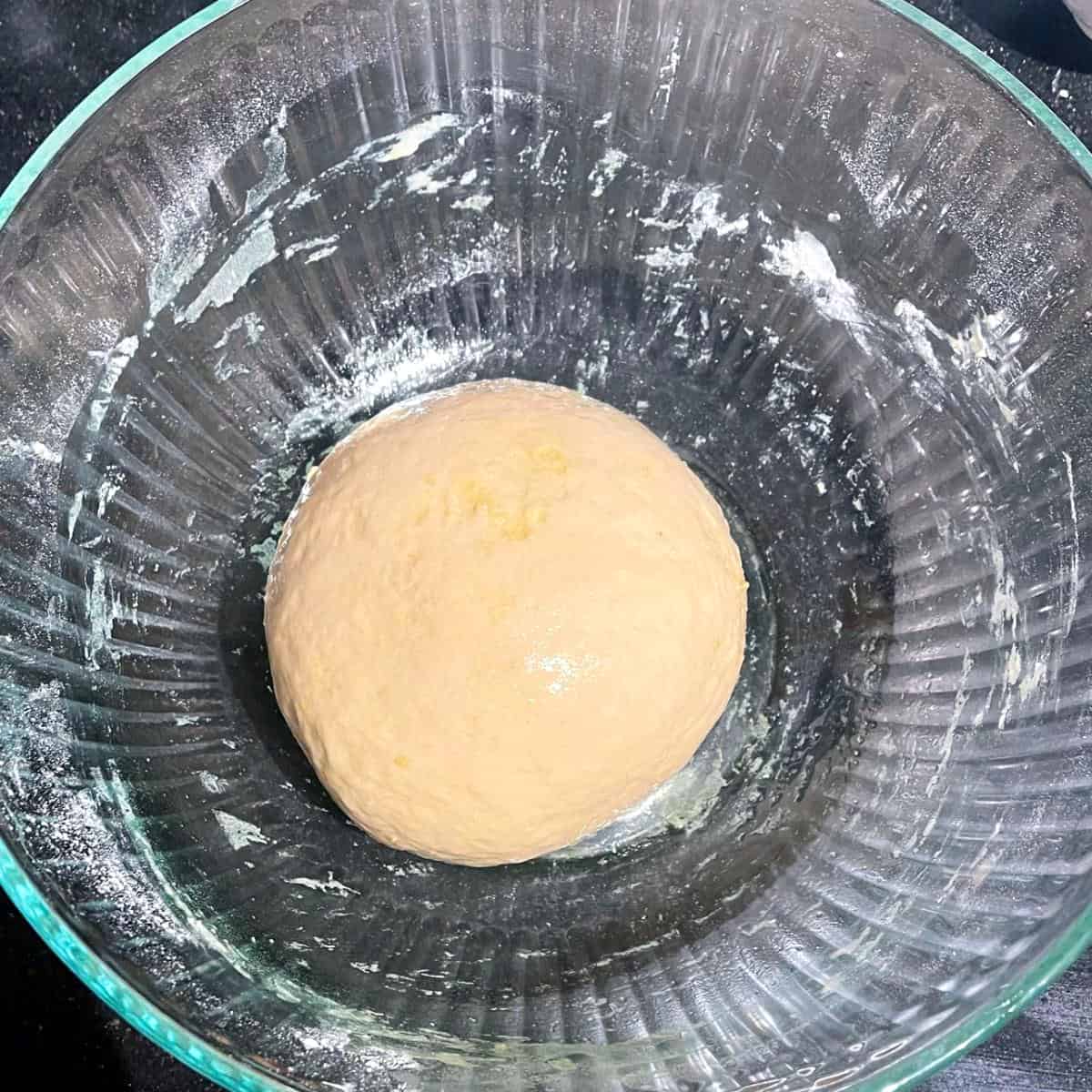
After six to seven minutes of kneading the dough should be smooth and supple and not sticky. Form into a smooth ball and place into an oiled bowl, making sure to oil the top of the dough.
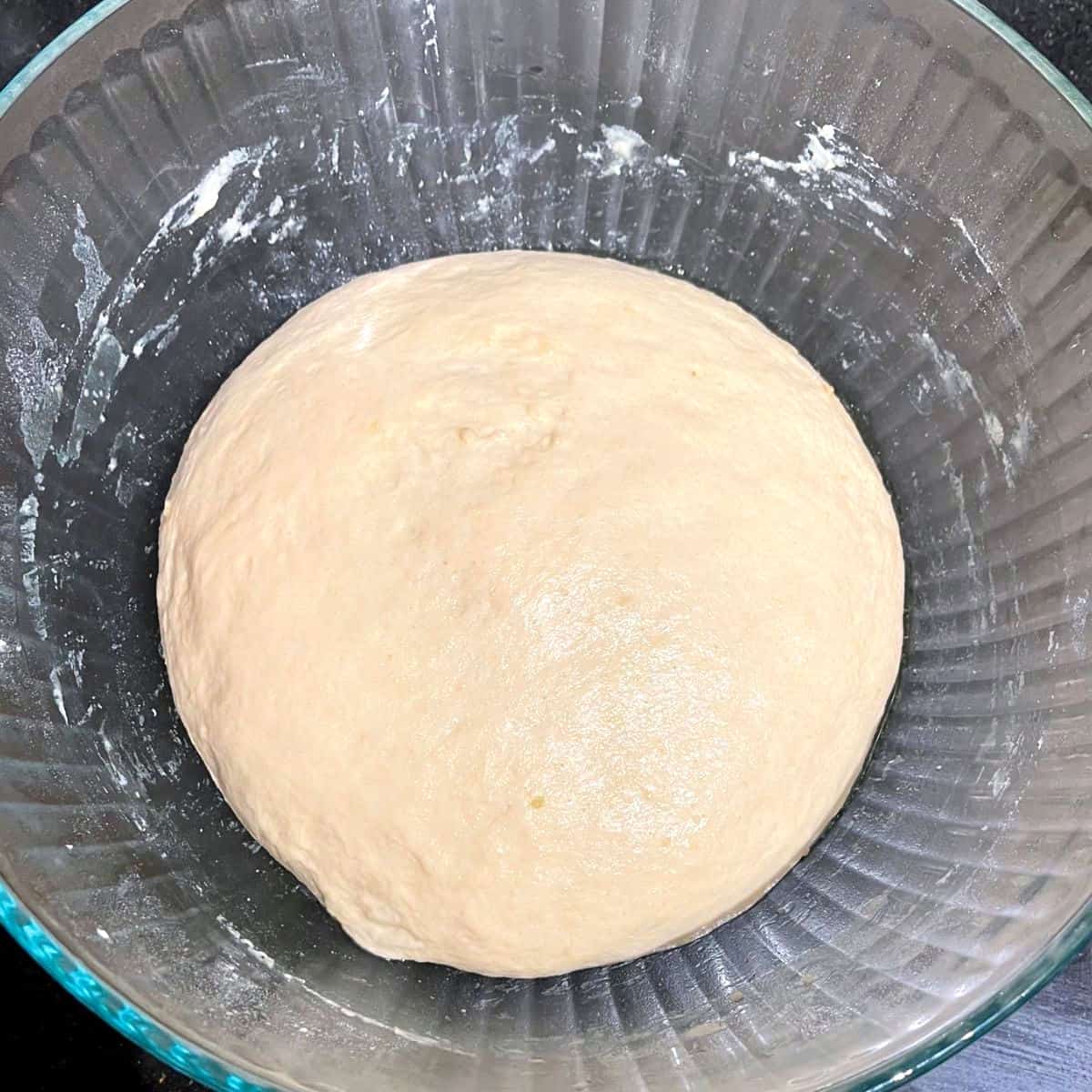
Cover the bowl with a lid or cling wrap and place in a warm spot for an hour or until it has doubled.
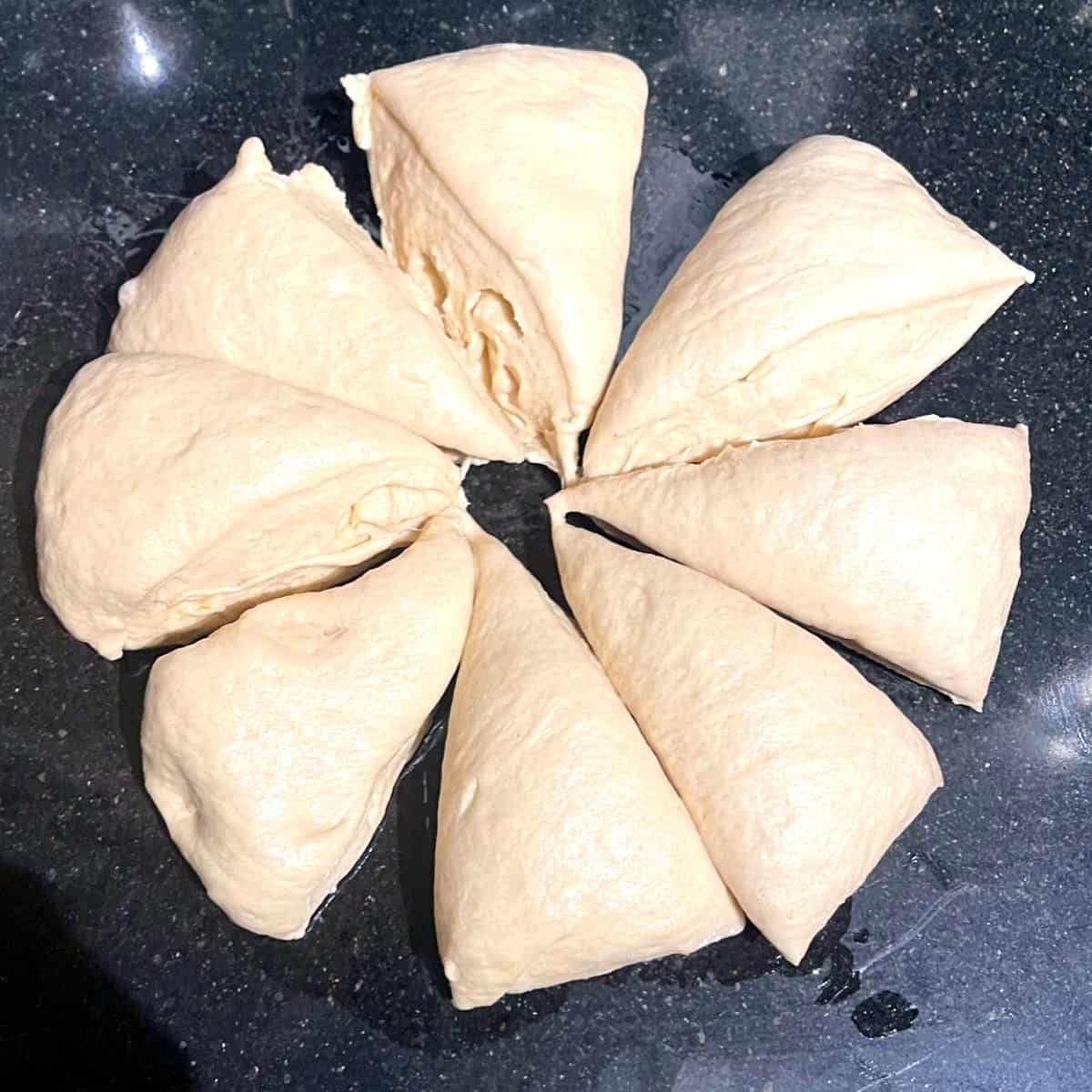
Turn out the dough mixture on an unfloured surface, knead lightly, form into a disc and cut into eight equal-sized pieces.
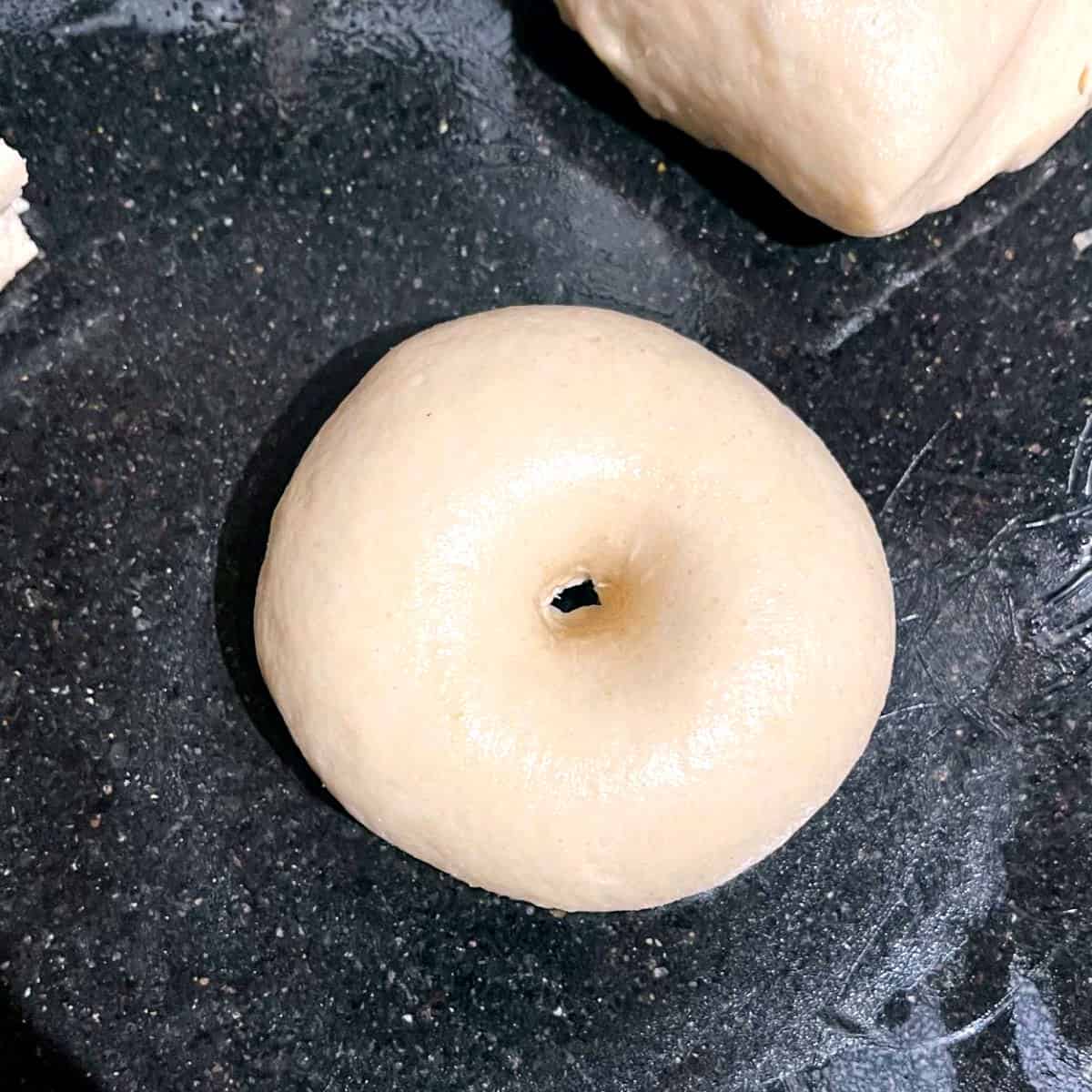
Roll one of the pieces into a smooth ball. To do this tuck the seams of the dough under and roll the ball of dough on the surface using the palm of your hand. Flatten slightly, then use your forefinger or a wooden ladle to make a hole in the center.
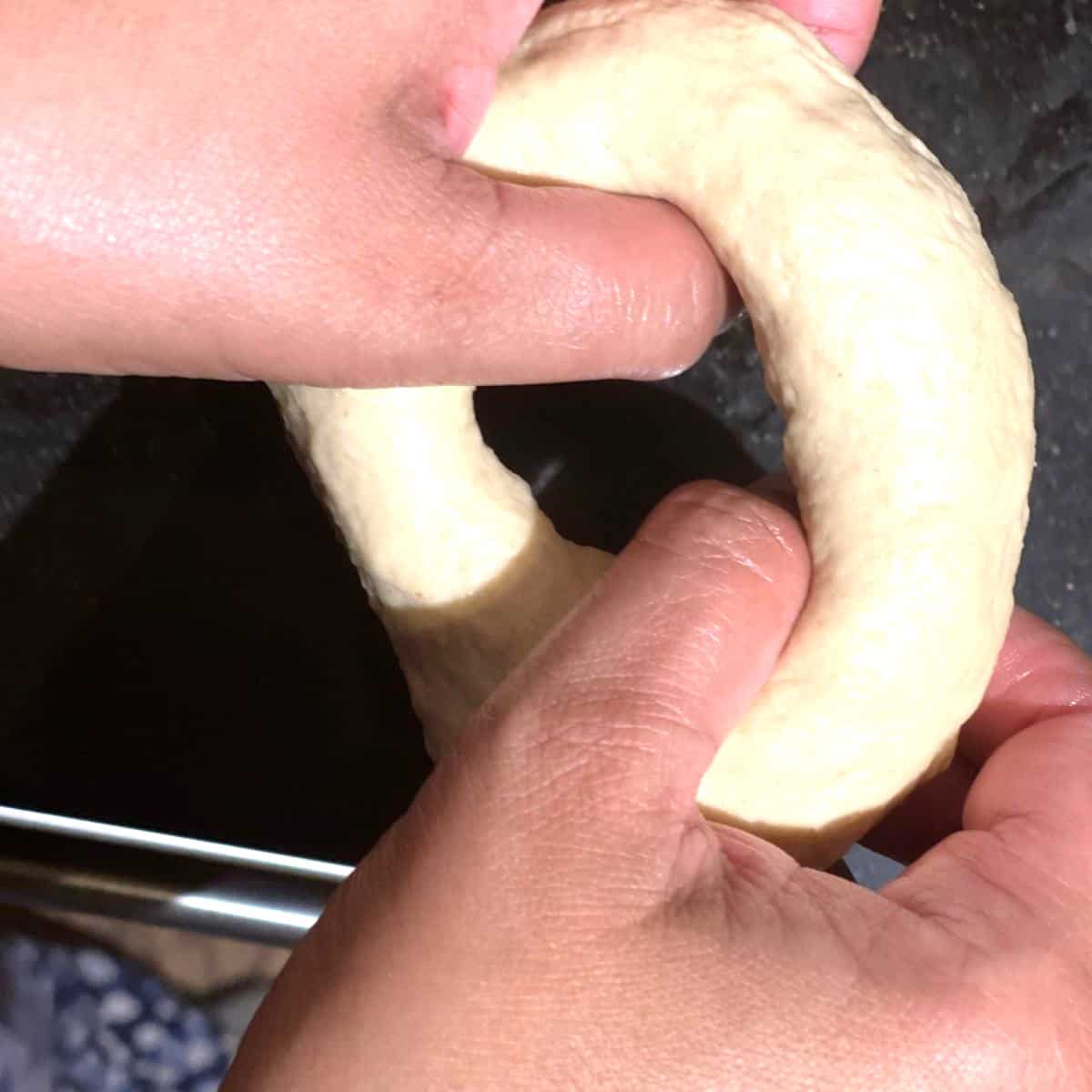
Hook both thumbs inside the hole and pull the sides outward until the hole expands to about 2-3 inches. It will look a little funny at this stage, but rest assured the dough will pull back and rise enough so you end up with a good-looking bagel.

Place the bagels on a baking sheet lined with parchment paper or a silpat sheet, cover loosely with a kitchen towel and set aside in a warm spot or on the countertop on a warm day.
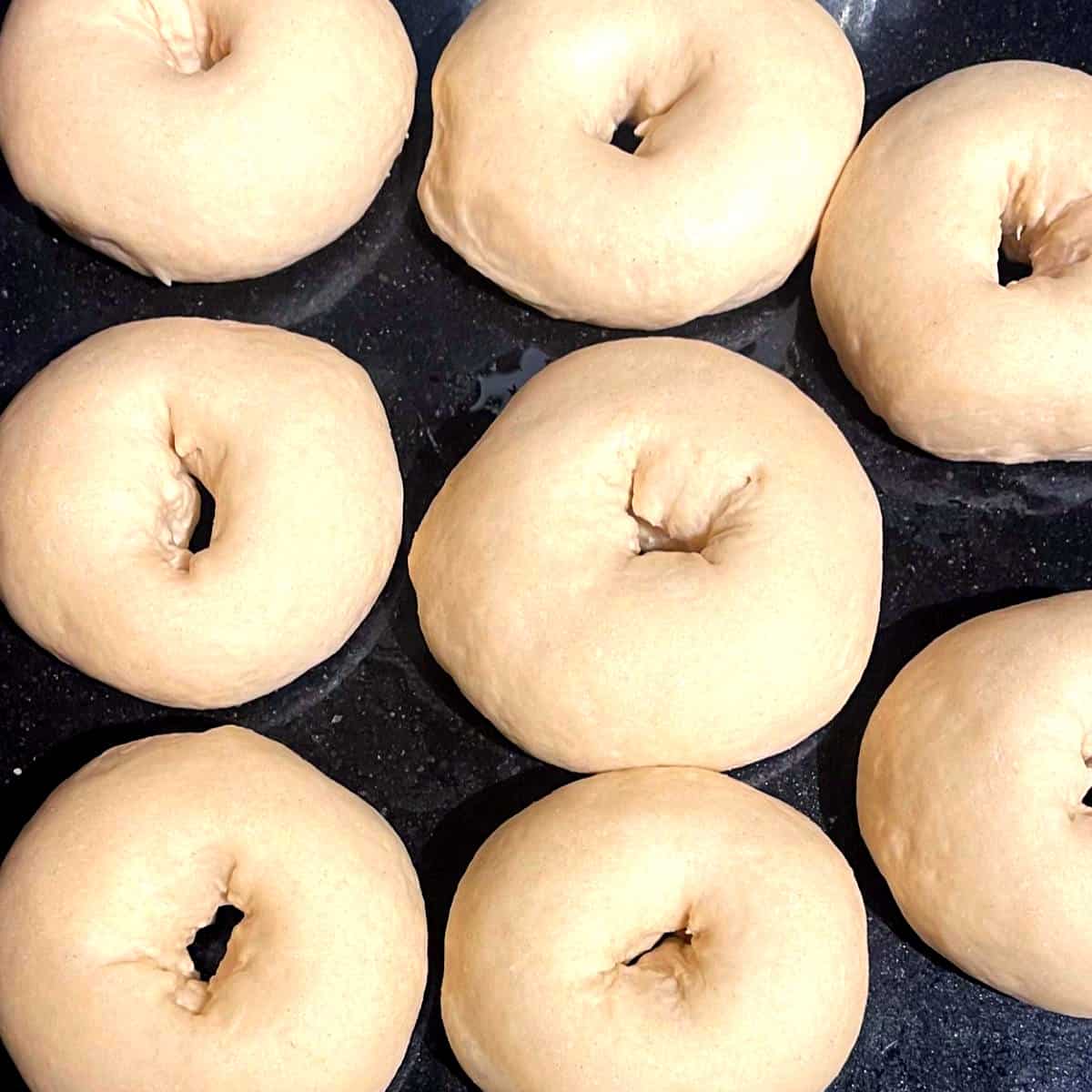
After 45 minutes to an hour the bagels should have doubled in size and become very puffy. About 20 minutes before the bagels are done rising, bring a large pot of water to a boil. Add 2 tablespoons of maple syrup or sugar to the water. Also preheat the oven to 425 degrees Fahrenheit/220 degrees Celsius.
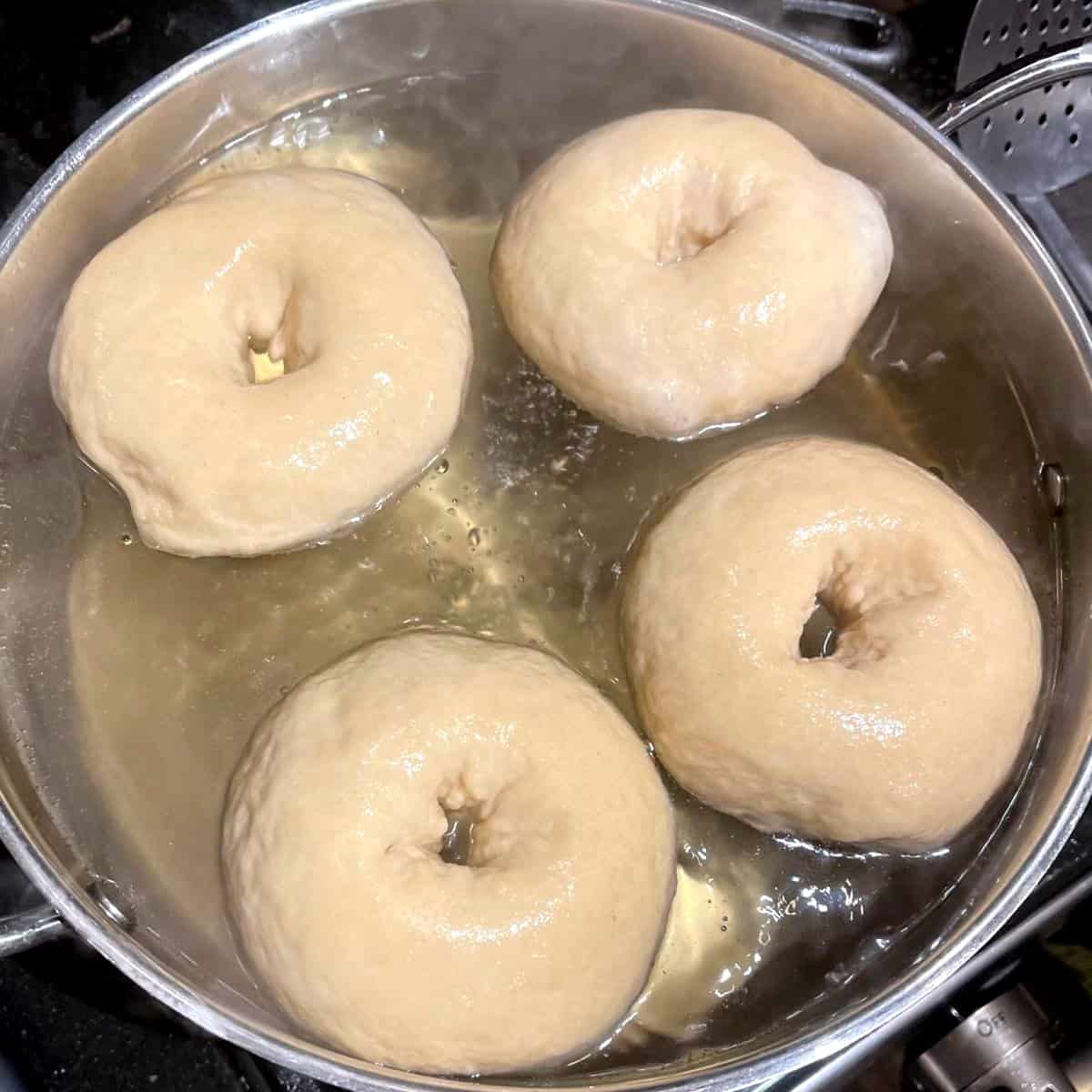
Gently lift the bagels and drop them into the water, making sure you don't overcrowd them. Immediately after putting them in the water set your timer to 45 seconds. After 45 seconds flip the bagels over and set the timer again for 45 seconds. As soon as the time goes off, remove the boiled bagels to a rack. Place seasoning in a bowl and immediately roll each bagel in the seasoning to coat. Alternatively you can brush a little more water on the bagels and sprinkle the seasoning on top. Place the bagels on a parchment- or silpat-lined baking sheet at least an inch apart.
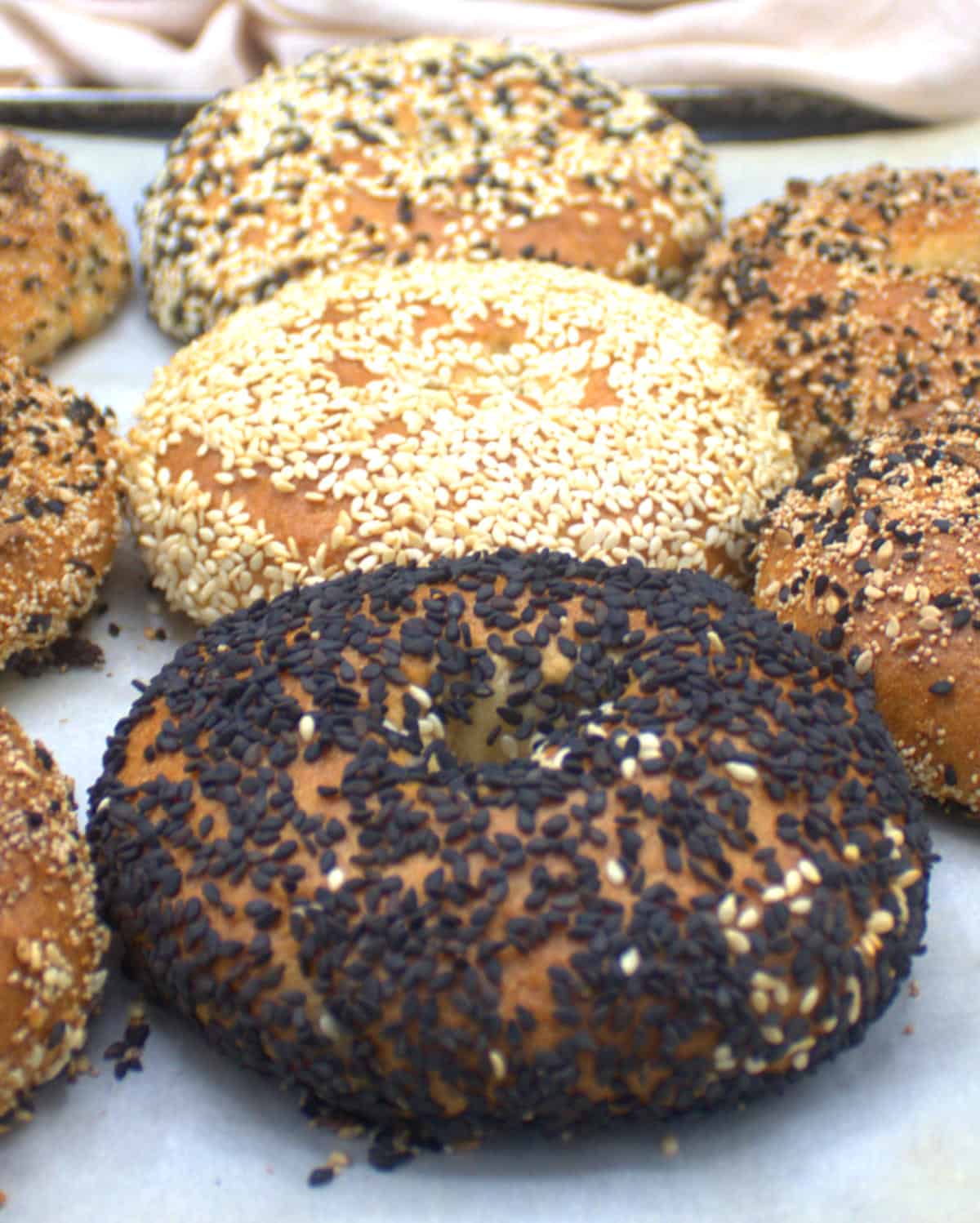
Bake in the preheated oven for 25 minutes, turning the sheet around once halfway through baking. Let the baked bagels cool on a rack before serving warm or at room temperature.
Helpful tips
- You might need only two cups of the all purpose flour or you might need more in order to get a smooth, soft, supple dough that doesn't stick. I've needed all 2 ½ cups at times, and at others I've needed just 2 cups and maybe one tablespoon more. Add more flour just a tablespoon or two at a time and be careful not to make a stiff dough.
- Knead the dough until it's very smooth and supple, which should take 6-7 minutes. A smoother dough will help you better shape the bagels and will also result in better-looking bagels.
- Similarly, after dividing the dough, make sure you shape the individual balls of dough as smooth as you can, taking care to tuck any ends underneath and sealing any open edges. This will ensure better-looking bagels. If you don't do it, and the bagels look a bit more, ahem, rustic, don't fret. They'll still look great after you've covered them with the seasoning and baked them.
- If the holes in the bagels look smaller than you want them to be after the bagels have risen, wait until the bagels have come out of the water bath. Then, before rolling the bagels in the seasoning, use your fingers to widen them a little bit.
- If you have leftover bagels, toast them the next day for a crunchy, crispy, delightful texture.
Recipe FAQs and troubleshooting
Bagels need bread flour for a chewier texture. You can use all purpose flour but that will result in a bagel with a lighter, airier crumb, more like bread than a bagel.
No, don't worry. The bagels will look a little funny after a turn in the water bath, but they will look puff up and look beautiful again after you bake them.
The reason bagels might end up flattening too much is because you let them swim in the boiling water for too long. Between 30 seconds and 1 minutes each on either side is all they need. Any longer and you risk over-proofing the bagels, which will result in flatter bagels. That said, if they flatten just a little after coming out of the water bath that is okay--they will puff up again in the oven.
The other reason why the bagels could end up flatter is if your dough was too soft. This will make the bagels spread out so they are wider and not as high, but the bagels should still taste great and should have a great texture.
Yes, absolutely. These bagels are delicious on their own and they will look beautiful with their shiny brown tops. You can also use just one of the seeds if you want to--sesame seeds or poppy seeds are wonderful seasonings on their own.
Vegan topping ideas for bagels
- Vegan cream cheese. Bagels are amazing with a schmear of cream cheese! You can serve the cream cheese plain or make your own flavored cream cheese by mixing in salt, garlic and herbs of your choice. Or, for a sweet tooth, add cinnamon and sugar or maple syrup.
- Hummus. Serve with healthy hummus, like this yummy black bean hummus, creamy edamame hummus or eggplant hummus.
- Butter. Bagels are divine with a pat of vegan butter. Or make a bagel sandwich with peanut butter and jelly.
- Scrambled chickpea eggs or scrambled tofu eggs.
- Thinly sliced vegetables, like sliced cucumber, sliced tomatoes, sliced avocados, sliced radishes and sliced onions. Serve these atop the cream cheese.
- Pickled or fermented vegetables, including sauerkraut.
Storage instructions
- Refrigerate: Bagels are best eaten fresh, but you can refrigerate them for up to a week.
- Freeze: Freeze bagels in a freezer-safe bag for up to a month.
- Reheat: Reheat bagels in a 400-degree Fahrenheit oven until warmed through. These bagels also toast beautifully.
More yummy vegan bread recipes
If you love this bagels recipe, check out more recipe tutorials on Holy Cow Vegan!

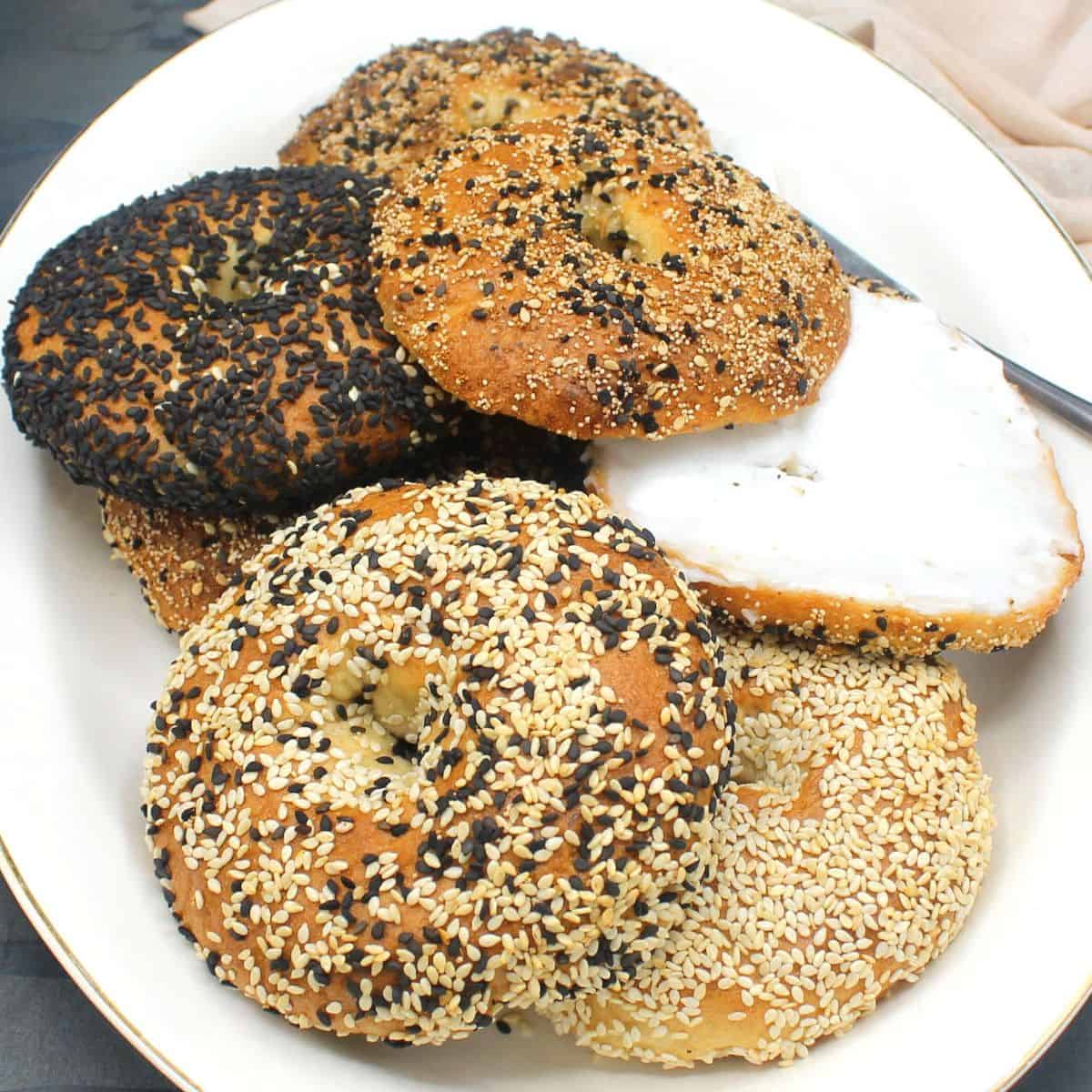
Bagels Recipe
Equipment
Ingredients
- 2 ¼ teaspoon yeast (1 package. Either active dry yeast or instant yeast is fine).
- 1 ¼ cups water (lukewarm)
- 2½ cups bread flour (you might not need all of it)
- 1 cup whole wheat flour
- 1 teaspoon sea salt or pink salt (or any salt of choice)
- 2 tbsps maple syrup + 2 tbsps for adding to water bath
- Olive oil for coating bowl
For optional bagel seasoning
- 2 tbsps sesame seeds (white or black)
- 2 tbsps poppy seeds
- 1 tablespoon nigella seeds (onion seeds)
- 1 tablespoon dried onion flakes
- 1 teaspoon garlic powder (or 1 tablespoon garlic flakes)1
- 1 teaspoon salt
Instructions
- Mix all seasoning ingredients together in a bowl and set aside.
- Place lukewarm water, yeast and maple syrup or sugar in a large bowl.
- Add one cup of whole wheat flour and two cups of bread flour to the bowl with the salt. Use a wooden spoon or your hands to mix until a dough forms. Turn out the dough on an unfloured surface and knead. If the dough seems too soft and sticky, add flour to it. You might need up to half cup more flour, but add only a tablespoon or two at a time.
- After six to seven minutes of kneading the dough should be smooth and supple and not sticky. Form into a smooth ball and place into an oiled bowl, making sure to oil the top of the dough.
- Cover the bowl with a lid or cling wrap and place in a warm spot for an hour or until it has doubled.
- Turn out the dough on an unfloured surface, knead lightly, form into a disc and cut into eight equal-sized pieces.
- Roll one of the pieces into a smooth ball. To do this tuck the seams of the dough under and roll the ball of dough on the surface using the palm of your hand. Flatten slightly, then use your forefinger or a wooden ladle to make a hole in the center.
- Hook both thumbs inside the hole and pull the sides outward until the hole expands to about 2-3 inches. It will look a little funny at this stage, but rest assured the dough will pull back and rise enough so you end up with a good-looking bagel.
- Place the bagels on a baking sheet lined with parchment or a silpat sheet, cover loosely with a kitchen towel and set aside in a warm spot or on the countertop on a warm day.
- After 45 minutes to an hour the bagels should have doubled in size and become very puffy.
- About 20 minutes before the bagels are done rising, bring a large pot of water to a boil. Add 2 tablespoons of maple syrup or sugar to the water. Preheat the oven to 425 degrees Fahrenheit/220 degrees Celsius.
- Gently lift the bagels and drop them into the water bath, making sure you don't overcrowd them. Immediately after putting them in the water set your timer to 45 seconds. After 45 seconds flip the bagels over and set the timer again for 45 seconds. As soon as the time goes off, remove the boiled bagels to a rack. Roll each bagel in the seasoning to coat. The water still clinging to the bagel will help the seeds adhere to the bagel. Place the bagels on a parchment- or silpat-lined baking sheet at least an inch apart.
- Bake the bagels in the preheated oven for 25 minutes, turning the sheet around once halfway through baking. Let the baked bagels cool on a rack before serving warm or at room temperature.
Notes
- You might need only two cups of the all purpose flour or you might need more in order to get a smooth, soft, supple dough that doesn't stick. I've needed all 2 ½ cups at times, and at others I've needed just 2 cups and maybe one tablespoon more. Add more flour just a tablespoon or two at a time and be careful not to make a stiff dough.
- Knead the dough until it's very smooth and supple, which should take 6-7 minutes. A smoother dough will help you better shape the bagels and will also result in better-looking bagels.
- Similarly, after dividing the dough, make sure you shape the individual balls of dough as smooth as you can, taking care to tuck any ends underneath and sealing any open edges. This will ensure better-looking bagels. If you don't do it, and the bagels look a bit more, ahem, rustic, don't fret. They'll still look great after you've covered them with the seasoning and baked them.
- If the holes in the bagels look smaller than you want them to be after the bagels have risen, wait until the bagels have come out of the water bath. Then, before rolling the bagels in the seasoning, use your fingers to widen them a little bit.
- If you have leftover bagels, toast them the next day for a crunchy, crispy, delightful texture.
- For cinnamon raisin bagels, add ¼ cup sugar and ½ cup raisins to the dough.
- For chocolate chip bagels, add ¼ cup sugar and ½ cup chocolate chips to the dough.
- For blueberry bagels, add ¼ cup sugar and 1 cup fresh blueberries to the dough. Cut down the water to 1 cup and add more flour if needed because the blueberry will express some juices.
- Refrigerate: Bagels are best eaten fresh, but you can refrigerate them for up to a week.
- Freeze: Freeze bagels in a freezer-safe bag for up to a month.
- Reheat: Reheat bagels in a 400-degree Fahrenheit oven until warmed through. These bagels also toast beautifully.
Nutrition
The post How to Make the Best Bagels appeared first on Holy Cow Vegan.


